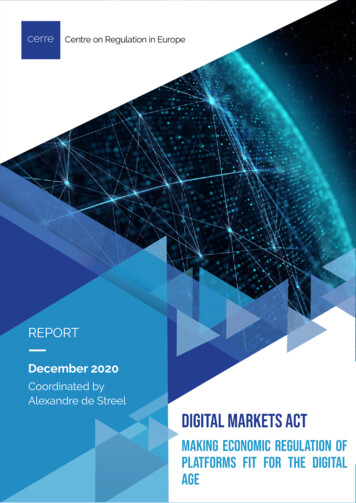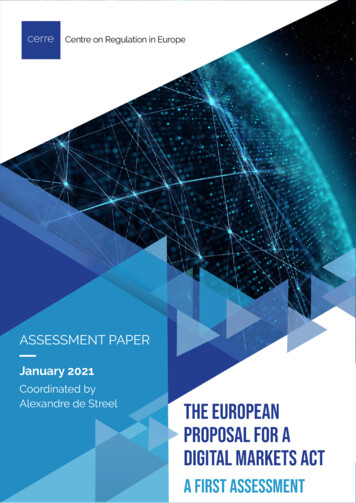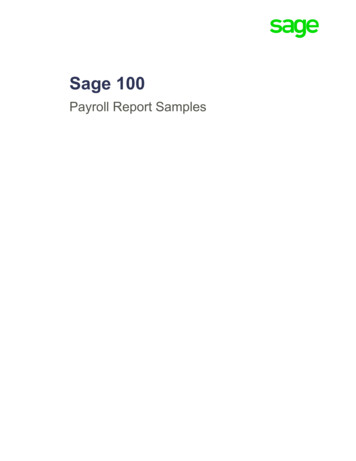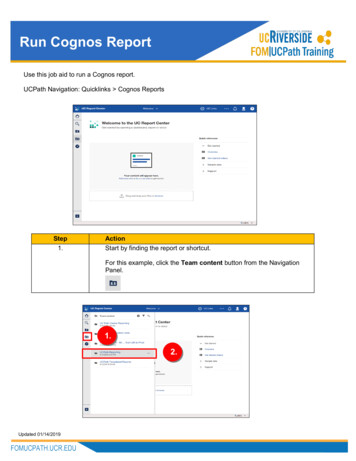
Transcription
REPORTDecember 2020Coordinated byAlexandre de StreelDecember 2020Digital Markets Act: Making economic regulation of platforms fit for the digital age0/108
The project, within the framework of which this report has been prepared, has received thesupport and/or input of the following organisations: ARCEP, AGCOM, Amazon, Apple, BIPT,Comreg, ComCom, Deutsche Telekom, Facebook, Microsoft, OFCOM, Orange, Qualcomm, Spotify,Vodafone. During the workshops, these participating members made very useful comments andsuggestions, including a number of views which have not necessarily been accepted by theauthors.The Issue Papers and the recommendations were prepared by a team of academics coordinated byCERRE Academic Co-Director, Alexandre de Streel, and including Martin Cave, Richard Feasey, JanKrämer and Giorgio Monti. The academic team also benefited greatly from very useful commentsby Amelia Fletcher. The non-attributable summaries of the discussions were prepared by ClaireMarie Healy, project manager at CERRE.As provided for in CERRE's by-laws and the procedural rules from its “Transparency &Independence Policy”, this report has been prepared in strict academic independence. At all timesduring the development process, the research authors and the CERRE Co-Academic Directors andDirector General remain the sole decision-makers concerning all content in the report. Copyright 2020, Centre on Regulation in Europe (CERRE)info@cerre.euwww.cerre.euDecember 2020Digital Markets Act: Making economic regulation of platforms fit for the digital age1/108
TABLE OF CONTENTSTABLE OF CONTENTS . 2ABOUT THE AUTHORS . 3BACKGROUND AND CONTEXT . 6ISSUE PAPER Conduct and theories of harm . 91Introduction . 92Assessing the competitive and welfare effects of firms’ conduct in the digital economy . 93Unilateral conduct with potential exclusionary effects .124Unilateral conduct with potential exploitative effects .15References .20DISCUSSION SUMMARY Conduct and theories of harm . 23ISSUE PAPER Threshold for intervention . 291Introduction .292Market definition .323Criteria to designate Large Gatekeeper Platforms .354Competition law test as a trigger for regulatory intervention .45References .46DISCUSSION SUMMARY Threshold for intervention . 48ISSUE PAPER Remedies . 541Scope and Aim of the paper.542Remedies in antitrust and regulation markets .543Issues arising in digital platform markets .61DISCUSSION SUMMARY Remedies . 68ISSUE PAPER Institutional considerations . 751Introduction .752Enforcement of the P2B Regulation .763DMA: Options for public enforcement .774Relationship between competition law and regulation .865Conclusions .89DISCUSSION SUMMARY Institutional considerations . 90RECOMMENDATIONS PAPER. 951Introduction .962Problems and objectives .963Scope, criteria for intervention and prohibitions/obligations .994Institutions and enforcement . 104ABOUT CERRE . 108December 2020Digital Markets Act: Making economic regulation of platforms fit for the digital age2/108
ABOUT THE AUTHORSAlexandre de Streel is an Academic Co-Director at CERRE andProfessor of European Law at the Universities of Namur and Louvainin Belgium. He is also the Director of the Research Centre forInformation, Law and Society (CRIDS), focusing his research onRegulation and Competition Law in the network industries. Alexandreregularly advises international organisations and national regulatoryauthorities on regulatory and competition issues in networkindustries. He holds a PhD in Law from the European UniversityInstitute.Richard Feasey is a CERRE Research Fellow, an independentconsultant and a Senior Adviser to the Payment Systems Regulatorin the UK. He lectures at University College London and Kings CollegeLondon. Richard was previously the Public Policy Director of VodafoneGroup plc from 2001 until 2013. In October 2017, he was appointedto the panel of the UK’s Competition and Markets Authority and inOctober 2018 to the National Infrastructure Commission for Wales.Giorgio Monti is Professor of Competition Law at Tilburg Law School.He began his career in the UK (Leicester 1993-2001 and LondonSchool of Economics (2001-2010) before taking up the Chair incompetition law at the European University Institute in Florence,Italy (2010-2019). While at the EUI he helped establish the FlorenceCompetition Program which carries out research and training forjudges and executives. He also served as Head of the LawDepartment at the EUI. His principal field of research is competitionlaw, a subject he enjoys tackling from an economic and a policyperspective. Together with Damian Chalmers and Gareth Davies heis a co-author of European Union Law: Text and Materials (4th ed,Cambridge University Press, 2019), one of the major texts on thesubject. He is one of the editors of the Common Market Law Review.Jan Krämer is an Academic Co-Director at CERRE and a Professorat the University of Passau, Germany, where he holds the chair ofInternet & Telecommunications Business. Previously, he headed aresearch group on telecommunications markets at the KarlsruheInstitute of Technology (KIT), where he also obtained a diplomadegree in Business and Economics Engineering with a focus oncomputer science, telematics and operations research, and a Ph.D.in Economics, both with distinction. He is editor and author of severalinterdisciplinary books on the regulation of telecommunicationsmarkets and has published numerous articles in the premierscholarly journals in Information Systems, Economics, Managementand Marketing research on issues such as net neutrality, data andplatform economy, and the design of electronic markets. ProfessorKrämer has served as academic consultant for leading firms in thetelecommunications and Internet industry, as well as forgovernmental institutions, such as the German Federal Ministry forEconomic Affairs and the European Commission. His current researchDecember 2020Digital Markets Act: Making economic regulation of platforms fit for the digital age3/108
focuses on the role of data for competition and innovation in onlinemarkets and the regulation of online platforms.Martin Cave is a member of the CERRE Board of Directors andProfessor at the Imperial College London. He is a regulatoryeconomist specialising in competition law and in the networkindustries, including airports, broadcasting, energy, posts, railways,telecommunications and water. Professor Cave has publishedextensively in these fields, and has held professorial positions atWarwick Business School, University of Warwick, and theDepartment of Economics, Brunel University.December 2020Digital Markets Act: Making economic regulation of platforms fit for the digital age4/108
December 2020Digital Markets Act: Making economic regulation of platforms fit for the digital age5/108
BACKGROUND AND CONTEXTThis research report comprises of several documents, including four Issue Papers, foursummaries of the discussions organised by CERRE throughout the second half of 2020, and therecommendations paper drafted by a team of academics on the basis of the Issue Papers and therelated discussions.This report is in line with CERRE’s ambition to remain at the cutting edge of regulatory developmentsin the digital and network industries and to constructively and independently contribute to the EUpolicy making process.Objective and topicsBuilding on previous and on-going CERRE work1 on the regulation of the online platform economy,this report focuses more specifically on the following four main sets of topics:1. The conduct and theories of harm;2. The thresholds for intervention;3. The remedies;4. The institutional considerations.MethodologyFor each of the four sets of topics, the following steps were followed: The CERRE academic team prepared Issue Papers that summarised, on the basis of themost recent academic literature and policy reports, the issues and their trade-offs as well asthe main policy proposals made so far. Each Issue Paper structured a brainstorming discussion during an exclusive eworkshop reserved for representatives of the CERRE members supporting the project andthe academic team. A summary of the discussion, underlining the main issues, trade-offsand possible solutions, as well as divergent views, was also written under Chatham HouseRule after each webinar. On the basis of these issue papers and the brainstorming discussions, the CERRE academicteam drafted a recommendations paper aimed at feeding the policy makers’ reflectionsfor the DMA.These include ‘Big Data and Competition Policy’, ‘Internet Platforms & Non-Discrimination’, ‘Market Definitionand Market Power in the Platform Economy’, ‘Remedies for anti-competitive intermediation bias’ and ‘Big TechAcquisitions’1December 2020Digital Markets Act: Making economic regulation of platforms fit for the digital age6/108
December 2020Digital Markets Act: Making economic regulation of platforms fit for the digital age7/108
Table of contentsISSUE PAPER Conduct and theories of harm . 91Introduction . 92Assessing the competitive and welfare effects of firms’ conduct in the digital economy. 9342.1Main characteristics of the digital economy . 92.2Assessing competitive effects in the digital economy . 102.2.1Economic and non-economic effects. 102.2.2Assessing economic effects . 10Unilateral conduct with potential exclusionary effects . 123.1Disincentives to switching and multi-homing . 123.2Leverage and envelopment . 133.3Self-preferencing and internal discrimination . 133.4Refusal to give access to key innovation capabilities . 14Unilateral conduct with potential exploitative effects . 154.1What constitutes an unfair/exploitative practice? . 154.2Unfair practices in the retail supply chain and in the digital economy . 16References . 20DISCUSSION SUMMARY Conduct and theories of harm . 23December 2020Digital Markets Act: Making economic regulation of platforms fit for the digital age8/108
ISSUE PAPER Conduct and theories of harm1 IntroductionIn its February 2020 Digital Strategy Communication,2 the Commission announced that the proposalof the Digital Services Act package would include one pillar aiming to achieve a fair andcompetitive economy through economic regulation. In their June 2020 Inception ImpactAssessment, the Commission services indicated that they are considering the following three policyoptions:1. Revising the horizontal framework set in the Platform-to-Business Regulation;2. Adopting a horizontal framework empowering regulators to collect information from large onlineplatforms acting as gatekeepers;3. Adopting a new and flexible ex ante regulatory framework for large online platforms acting asgatekeepers. This option is divided into the following sub-options:3a. Prohibition or restriction of certain unfair trading practices (“blacklisted” practices);3b. Adoption of tailor-made remedies addressed on a case-by-case basis where necessaryand justified.3This Issue Paper is organised as follows. After this introduction, Section 2 deals with the maindifficulties and trade-offs in assessing the competitive and welfare effects of a conduct in the digitaleconomy. Section 3 deals with the forms of unilateral conduct which are mainly exclusionary. Section4 deals with the forms of conduct which are mainly exploitative. Of course, some types of conductmay be at the same time exclusionary and exploitative (for instance, the decision of the Germancompetition authority against Facebook mentions that the data collection by Facebook could haveexclusionary and exploitative effects).2 Assessing the competitive and welfare effects offirms’ conduct in the digital economy2.1Main characteristics of the digital economyThe Crémer Report mentions three key characteristics of the digital economy, namely the extremereturn to scale, network externalities and the crucial role of data as a key input for many onlineservices and AI. Those characteristics lead to strong economy of scope and favour the developmentof ecosystems. Petit (2020:127-150) identifies six properties common to many of the big tech firms:(i) diversification in different markets and conglomeralism; (ii) discontinuity due to the uncertainevolution of technology, entry and regulation; (iii) long-termism relying on patient capital; (iv)growth, (v) exploration and discovery and (vi) flexibility.On that basis and different other policy reports, we can identify the following key characteristicsof the digital economy:-Economies of scale and scope on the supply-side;-Direct and indirect network effects on the demand-side;-Conglomeralism and creation of an ecosystem;-High rate of innovation, hence the importance of controlling the key innovation capabilities:data, skills, computing power, user base, risky and patient capital;2Communication from the Commission of 19 February 2020, Shaping Europe's digital future, COM(2020) 67.Inception Impact Assessment on Digital Services Act package: Ex ante regulatory instrument for large online platforms withsignificant network effects acting as gate-keepers , available at: -online-platforms-acting-asgatekeepers3December 2020Digital Markets Act: Making economic regulation of platforms fit for the digital age9/108
-Uncertainty in the evolution of technology and markets.Some platforms may have a gatekeeper function when their customers mostly single-home andhave no – or little - ability and incentive to multi-home because of lack of information, high switchingcosts or biases and heuristics. In this case, such a platform is the main gate, or bottleneck, to thiscustomer base. This may raise competitive issues when the platform is providing intermediationservices and competing with other firms in providing some of the intermediated services.2.2Assessing competitive effects in the digital economy2.2.1Economic and non-economic effectsOnline platforms bring many benefits which can be estimated in different manners.4 One way isto assess how much users are ready to pay for the service. Brynjolfsson, Collis, and Eggers (2019)ask Facebook users to specify what monetary compensation they would need to give up their use ofthe service for a month and found that in 2016-7, the monthly figure for US participants in thesurvey was at the 35-50 level. The figure for access to search engines was even higher. Anotherway is to estimate the value of the content provided by attention platforms. Evans (2017) indicatesthat, in 2016, American adults spent 437 billion hours on ad-financed attention platforms. On thebasis of the opportunity cost of the time, Evans calculates that this time was worth 7.1 trillion usingthe average after-tax hourly wage rate and 2.8 trillion using the average after tax minimum wagerate, which can thus be the value of the content of those platforms.However, online platforms also increase risks. Some risks are broad and societal. Forinstance, Allcott et al. (2020) found that a four-week period without Facebook ‘improves subjectivewell-being and substantially reduces post-experiment demand, suggesting that forces such asaddiction and projection bias may cause people to use Facebook more than they otherwise would.’Also, some intermediaries have become so large that they do not merely manage a private spacebut control part of the public sphere, or that they have acquired very substantial information andsurveillance power, which may need to be tamed (Cohen, 2019; Zuboff, 2019). Other risks raisedby the platforms are linked to the working and the contestability of the markets as the sizeand business models of some platforms may threaten competition and innovation. This issue paperfocuses on those latter risks.2.2.2Assessing economic effectsIn the digital economy, the assessment of the economic effects of firms’ conduct is particularlycomplex because a behaviour often leads, at the same time, to pro and anti-competitiveeffects. For instance, the growth of a digital platform within the same relevant market and thetipping of such a market is beneficial to consumers when there are important direct or indirectnetwork effects and when interoperability is difficult, impossible or costly to do or to impose.Similarly, the extension of a digital platform from one core market to another related market in orderto offer a more complete suite of products and enlarge the ecosystem may benefit consumers assuch an extension increases the ecosystem’s synergies; such conglomerate diversification may alsoincrease the economies of scope on the supply-side.5 However, such an extension may also lead tothe exclusion of as-efficient niche competitors. Thus, assessing the competitive effects of conduct indigital markets often requires a difficult balancing of pro and anti-competitive effects. This is notspecific to digital markets, but possibly more frequent in digital markets.Thus, assessing the economic effects of digital firms’ conduct involves several trade-offsbetween different values and interests. Examples of those trade-offs are the following:-45Short-term and long-term: a type of conduct may increase consumer welfare in the shortterm, for instance by increasing short-term competition or innovation, but at the expense ofconsumer welfare in the long-term, for instance by decreasing the ability and incentive tocompete and/or innovate in the future. The most difficult situation occurs where there areSee Cave (2020).As explained in Bourreau and de Streel (2019).December 2020Digital Markets Act: Making economic regulation of platforms fit for the digital age10/108
clear short run efficiency benefits and a long-term competitive harm that is more uncertainbut potentially very serious. This is even more difficult is when there are short-run benefitsto one type of competition, to be traded off against a long-term risk to another type ofcompetition. For example, self-preferencing can sometimes make it easier for one largegatekeeper platform to enter or grow in a market to compete against other large gatekeeperplatforms (e.g. in untipped markets, competition between large gatekeeper platforms couldbe especially important and potentially a more sustainable type of competition)6.-Competition and innovation: a type of conduct may increase the development and/orpropagation of innovation (at least in the short run), but at the expense of competition. Tomake matters more complex, there can be trade-offs between different types of innovation.Indeed, Ofcom (2019, para.5.29) notes that: “Consumers can benefit from different typesof innovation, realised by different types of competitors. The ideal would be for regulatoryintervention to preserve incentives for all types of beneficial innovation. However,intervention aimed at promoting one type of innovation may have a detrimental effect onanother. As such, regulators may have to trade off different types of innovation. This mayoccur where requiring an incumbent to give access to its data provides opportunities forinnovation by smaller players and entrants, but weakens incentives for innovation by theincumbent.”-Sustaining and disruptive innovation: a type of conduct may stimulate sustaininginnovation, for instance big tech acquisition may stimulate entry for buy out, but at theexpense of disruptive innovation which takes place outside the value network of the existingfirms.Arbitrating trade-offs is one of the main roles of regulatory agencies and the judiciary (hence, Themisis often represented with a balance in her hands), but such arbitration is particularly difficultin the digital economy because the trade-offs are amplified and have to be decided in ahighly uncertain environment.Given those difficulties, the risks of regulatory failures and errors, of type I and type II, mayalso be amplified in the digital economy.7 Those risks can be decreased by reducing theinformation asymmetry between the digital firms and the public authorities and by increasing thelearning curve of the authorities. This can be achieved with better understanding of the digitaleconomy through studies, sector enquiries and market investigation and individual cases, as well aswith information disclosure through appropriate rules and presumptions. Also, the costs of type Iand type II errors may also be amplified in the digital economy. Those costs should also bedecreased, in particular through timely intervention when necessary.Some commentators8 point to the amplified difficulties in assessing the competitive effects ofconduct and the higher costs of type II errors in the digital economy compared to the other sectorsof the economy to call for more structural analysis. They do not call for a return to the StructureConduct-Performance paradigm of the sixties and pure structural analysis but to complementconduct analysis with structural analysis.Moreover, the assessment of firms’ conduct in the digital economy involves two additional difficultiesthat will be dealt in the forthcoming Issue Papers:-678First, a conduct may be welfare-detrimental, even though the firm does not enjoya dominant position. In this case, the market failure is due to a structural problem, whichis often situated on the demand-side of the market. This could be solved with the impositionof remedies on all the firms or at least on the most important firms in the market, evenSee Petit (2020).On the difficulties in regulating the digital economy and the risks of regulatory failures, see Ofcom (2019: Section 5).Valletti (2020).December 2020Digital Markets Act: Making economic regulation of platforms fit for the digital age11/108
when they are below the dominant threshold. This issue will be discussed in the second IssuePaper on remedies.-Second, the same welfare-detrimental conduct may violate different legal rules suchas competition law, consumer protection or data protection rules. This is not specific todigital but seems to be more common in the digital economy. Remedying such conductrequires an efficient allocation of tasks between different regulatory agencies. This issue willbe discussed in the third Issue Paper on institutional design.3 Unilateral conduct with potential exclusionary effects3.1Disincentives to switching and multi-homingNext to conduct which may have an exclusionary effect on the supply-side of the market, otherconduct may have exclusionary effects on the demand-side of the market by increasing, for users,the costs of switching and/or multi-homing. They can cover a series of practices:-Vertical restraints such as exclusivity, MFNs or anti-steering clausesOne way to increase switching costs is with vertical restraints contractual practices. This can be inthe cases of: Long duration or exclusivity clauses9 or cases of requiring default/pre-installation status onentry points such as handsets or browsers, which is not strictly exclusivity but can have verysimilar effects given consumer default bias. Examples are the Google Android decision aswell as concerns about Google paying Apple for default position on the iPhone/iPad; Retail price Most Favoured Nations (MFNs) Clauses which may disincentivise consumers fromsearching around, and thus create more single homing; Steering behaviour which may keep consumers within ecosystems. One example could beAmazon's steering of its customers towards taking Amazon PrimeAs explained in the economic literature, those practices may have positive and negative competitiveand welfare effects. On the positive side, exclusivity clauses may alleviate free-riding, for instanceon distributor investment and ensure quality in distribution; alleviate hold-up of client-specificinvestment made by the supplier or the distributor or solve double marginalisation when supplierand distributor take a margin. On the negative side, exclusivity clauses may raise rival costs andforeclose suppliers or buyers; may reduce inter-brand competition (between suppliers of competingbrands) and soften competition and/or facilitate collusion between suppliers and may reduce of intrabrand competition (between distributors of the same brand): soften competition and/or facilitatecollusion between buyers.-Data portabilityAnother way to increase the costs of switching and multi-homing is by limiting the portability of databetween platforms. Indeed, data represent a key asset, not only for the platforms as explainedabove, but also for users of social networks (e.g. posts on Facebook), music streaming (e.g. theplaylist) or booking sites (e.g. the customer’s reviews and evaluations). In those cases, users maybe reluctant to switch or multi-home if they cannot bring ‘their’ data with them.Recent EU legislations, in particular the GDPR,10 provide the right to data portability and shouldcontribute to make the markets work better. However, Krämer, Senellart and de Streel (2020) showSee Commission Decision of 20 March 2019, Case AT.40411 Google Search (AdSense).Regulation 2016/679 of the European Parliament and of the Council of 27 April 2016 on the protection of natural persons withregard to the processing of personal data and on the free movement of such data, and repealing Directive 95/46 (General DataProtection Regulation), OJ [2016] L 199/1, art.20.910December 2020Digital Markets Act: Making economic regulation of platforms fit for the digital age12/108
that the scope of those portability rights is still legally uncertain and is, in any case, too limited tofacilitate switching or multi-homing across several attention intermediaries.3.2Leverage and envelopmentAccording to Eisenmann, Parker and Van Alstyne (2001:1271), “envelopment entails entry by oneplatform provider into another’s market by bundling its own platform’s functionality with that of thetarget’s so as to leverage shared user relationships and common components”. This is commonpractice on the digital markets and allows entry in new markets without Schumpeterian innovation.The authors give the examples of Microsoft having enveloped Netscape’s Web
December 2020 Digital Markets Act: Making economic regulation of platforms fit for the digital age 6/108 BACKGROUND AND CONTEXT This research report comprises of several documents, including four Issue Papers, four summaries of the discussions organised by CERRE throughout the second half of 2020, and the recommendations paper drafted by a team of academics on the basis of the Issue Papers and the










